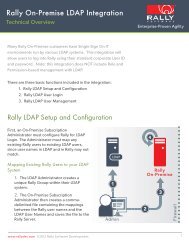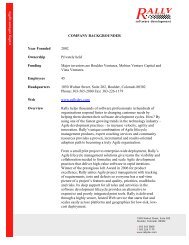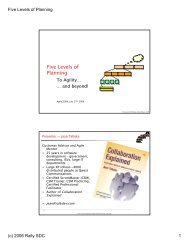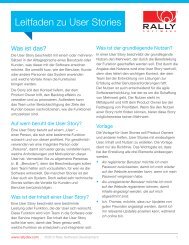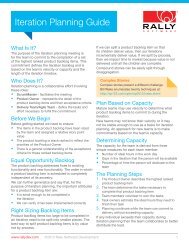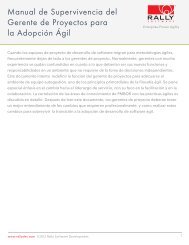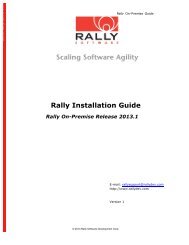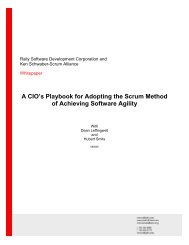The Agile Impact Report - Rally Software
The Agile Impact Report - Rally Software
The Agile Impact Report - Rally Software
You also want an ePaper? Increase the reach of your titles
YUMPU automatically turns print PDFs into web optimized ePapers that Google loves.
As <strong>Agile</strong> Goes Mainstream It’s Time for Metrics<br />
Key Disruptive Trends Driving <strong>Agile</strong> Adoption<br />
by Melinda Ballou, Program Director, Application Life-Cycle Management & ITMS, IDC.<br />
Increasingly, organizations create software via a complex, distributed supply chain that spans<br />
organizational boundaries and multiple software sources. As a result, communication between business<br />
stakeholders and a diverse range of IT resources has become increasingly more problematic. With<br />
disparate teams, disparate partners and disparate code sources, how can companies create a coherent,<br />
managed approach?<br />
In this context and that of our current, difficult global economy, the business benefits of <strong>Agile</strong><br />
development approaches become visceral and demonstrable. With highly constrained resources,<br />
organizations have little leeway for the long time-to-market, poor communication, and delayed benefits<br />
that typically accompany traditional waterfall approaches.<br />
As a result, in part, IDC sees <strong>Agile</strong> adoption going increasingly mainstream. <strong>The</strong> disruptive factors of<br />
complex sourcing, regulatory and localization compliance demands, mergers and acquisitions, and<br />
emerging technology issues (such as Web 2.0, SOA and security concerns) have already driven a majority<br />
of organizations towards iterative processes and <strong>Agile</strong> approaches. For companies that remain solely<br />
entrenched in a waterfall approach, the business costs and consequences of long and late software project<br />
cycles are becoming untenable in dynamic, global competitive environments.<br />
Along with increased adoption comes the need for effective metrics to validate the benefits of <strong>Agile</strong> and to<br />
evolve enterprise deployments. Quantitative metrics facilitate qualitative decision-making to sustain<br />
on-going improvements and support <strong>Agile</strong> strategies across groups, departments and divisions.<br />
<strong>The</strong> Potential Benefits of <strong>Agile</strong> – Faster Time-to-Market and Improved Productivity<br />
IDC research indicates that 70-80% of software development failures result from poor requirements<br />
gathering, analysis and management. Proactive, well-managed <strong>Agile</strong> approaches can help to solve those<br />
problems by enabling quick and frequent feedback across the cultural divide between business and IT, and<br />
can also bridge the gap to operations and provisioning. <strong>Agile</strong> engages IT and the business through each<br />
phase to chunk larger initiatives into key segments that can improve time-to-market by delivering quickly<br />
on the initiatives of greatest priority to the business. Where effective, this enables IT teams to support<br />
businesses in being more responsive to emerging, dynamic market needs.<br />
<strong>The</strong> potential for productivity gains are another key driver for establishing <strong>Agile</strong> approaches. Additionally,<br />
the mentoring of new teams by mature <strong>Agile</strong> teams can help establish broader <strong>Agile</strong> adoption and a more<br />
dynamic software development approach for business support. In short, one team’s success with <strong>Agile</strong><br />
development can be an example to lead to organizational adoption and further productivity<br />
improvements by other teams and across the board. It is also useful to establish <strong>Agile</strong> as part of an overall<br />
application life cycle approach. Understanding community collaboration and <strong>Agile</strong> development (from<br />
requirements through test and build) can help evolve organizations beyond current, typical application<br />
creation.<br />
As an example, <strong>Agile</strong>, iterative testing improves quality. In fact, some <strong>Agile</strong> practitioners incorporate<br />
leading Quality Assurance (QA) staff as ScrumMasters to establish strong links between QA and their <strong>Agile</strong><br />
process. Managing relevant data associated with <strong>Agile</strong> projects from an end-to-end perspective provides<br />
context for overall integration, and also for the ways in which the software artifacts meet corporate<br />
policies and address key business needs and workflow.<br />
Coupled with effective process and organizational strategies, <strong>Agile</strong> development can enable the software<br />
ecosystem to become a strategic asset, rather than spawning disparate, sprawling entities that are isolated<br />
from one another and from the business.<br />
1



